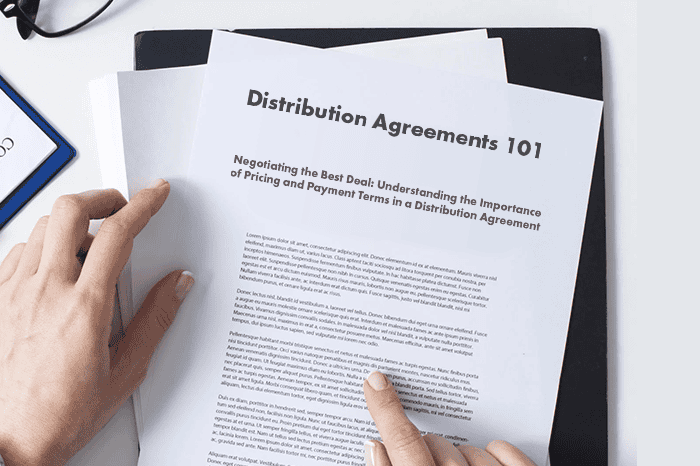Table of Contents

A distribution agreement facilitates the exchange of products from a supplier company to a distributor. Through the agreement, each party seeks to secure the best deal and incline the pricing of the purchase or sale in their favor. Negotiating the most suitable deal does not always means securing the best pricing deal. It can also entail factors like the quality of the products, the delivery timing, and the method of payment. With that stated, it is vital to understand the relevance of pricing and payment terms in a well-negotiated distribution agreement.
The most efficient deals tend to conclude with both parties feeling comfortable and satisfied. A long-term trade relationship indicates a successful negotiation. These tactics will guide you to a successful negotiation:
1)Set your objectives
Prior to initiating any negotiations with a supplier, a distributor should create an objective while conducting a range of considerations. In order to set an objective for purchase negotiations, a distributor should consider the price of purchase, price of sale, the intended margin of profit, the aggregate cost, the after-sales service and management facilities, and compare it with their available resources. It is also helpful to draw out a list of subjects that your company may or may not be comfortable compromising on. While securing a deal that is profitable to your company can be beneficial for the short term, you will notice that creating a long-term relationship will prove to be more advantageous in the long run.
2)Know your supplier
A short research on your suppliers will help you understand how important your business is to your potential suppliers. It will also help you leverage your bargaining power in order to secure a favorable deal. If your potential supplier’s business has a monopoly over the market in terms of its product, it is more likely for them to have the upper hand or greater bargaining power in the negotiation process. If they have multiple competitors, are new to the market, are seeking to get rid of old stock, or are a smaller company, the chances are, your company as a distributor can secure a favorable deal. Time may also act as a variable in determining the success of your ability to negotiate. You can use these factors as a strategic tool to negotiate a reasonable deal.
3)Strategize the negotiation
Before negotiating, you can write down your strategies to identify plans that you may develop further. Not only will this help you identify a set goal, but also recognize the limits for compromises. You will have to define your priorities and estimate the most likely offer of your potential suppliers. Additionally, writing your negotiation strategies will help you highlight your strengths that may be useful in incentivizing concessions from the other party. This is also an opportune step to finding and defending your weaknesses. Overall, strategizing your negotiations will help you create a stronger argument to create a favorable deal.
4)Negotiate the price
While negotiating the price, you do not have to concede to the first offer. You can make a counteroffer that may be more profitable for you. Your suppliers will provide you with a revised figure. You can also ask the negotiating party to increase what they were including in the initial price. However, a low price does not always equal profit. If the price is suspiciously low for the product, you will have to consider its quality. Be mindful to enquire about the aggregate cost after repairs, consumables, and other expenditures. Sometimes the supplier may include features and products that you do not require. You can ask them to remove those items and request a cost reduction.
You can leverage your bargaining power for a better deal. If you are the sole distributor for the company, you can seek bulk discounts. However, you need to be cautious because seeking to reduce the price too low may lead to you losing a good deal. Even in the case where your company is the sole provider to the company, make sure you do not tarnish your relationship by demanding unreasonable prices that may cause the business to face losses. Being too rigid might cost your company its reputation.
5)Draw a contract
When you reach an agreement on the negotiation for all the points, you should draw a written contract or a distribution agreement. Having a written contract allows you to make the agreement legally binding and holds armstrong evidentiary value in the courts. The content of the contract is agreed upon by both parties. This means that it should include the pricing terms, the schedule for delivery, a clause concerning the supplier’s right to ownership, clausing limiting the liability of the supplier, and a consideration of the distributor’s statutory right.
The terms and conditions of the contract need to be written clearly and its mention infers that both parties understand their responsibilities. It is advisable to get legal suggestions while formulating the terms and conditions of the contract. Explicitly asking about the problems that may arise can be beneficial to both parties when unfavorable circumstances arrive in the future.
A well-drafted distributor’s agreement also includes provisions concerning conflict resolution and a clause for termination. A termination clause provides clarification to both parties about the circumstances in which the agreement will no longer be practiced and the expiration of the agreement.
Importance of pricing and payment terms
A pricing agreement in a distribution agreement includes sales and resale prices. The sale price is the price at which the distributor purchases products from the supplier. Likewise, the resale price is the price at which the distributor sells the products to the customers. Vertical price fixing for resale prices is prohibited under the law as it can impact the competition in the market.
The pricing and payment terms are a crucial part of the distribution agreement because they outline the rate at which a distributor purchases a product from the supplier. It sets the incentive for the deal and outlines the method of payment a distributor can use. Sometimes, payment or pricing terms also include any discounts that a supplier is providing a distributor.
Conclusion
If you are seeking a supplier for your distribution company and you want to negotiate the best possible deal, you should set your objectives for the negotiation, understand your potential supplier and their products, strategize the methods of negotiation, and carefully draft the contract. Pricing and payment terms should be particularly focused on in the contract as they set the primary incentive for the exchange.
You might also like:
- Distribution Agreements 101: Balancing Risks and Rewards (Part-1)
- Distribution Agreement Template
- Manufacturing Agreement Template
- Purchase Order Template
- Software Reseller Agreement
Raveena Rani
Raveena is a seasoned International IP Counsel with a unique blend of engineering and legal acumen, specializing in Intellectual Property, Technology Law, and Corporate Transactions. She has extensive experience drafting and negotiating NDAs, commercial agreements, and legal documents in the areas of M&A, SaaS, and AI. Her global perspective is complemented by hands-on internships, corporate counsel roles, and mentoring initiatives. She thrives at the intersection of law, business, and technology.






